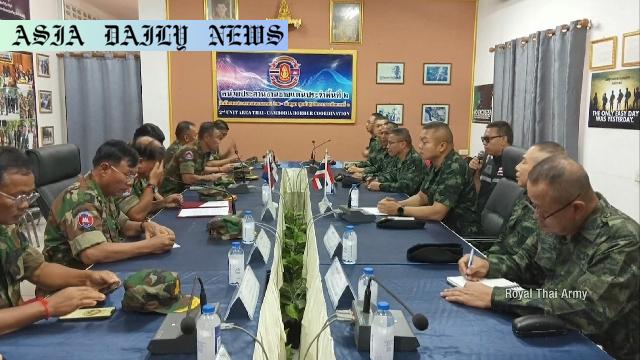Ceasefire: This year’s ASEAN Chair, Malaysia, is forming two dedicated teams to monitor and verify the ceasefire agreement.
- Malaysia deploys monitoring teams to Cambodia and Thailand.
- Dedicated ASEAN-led efforts to oversee ceasefire agreement.
- Military commanders from both nations commit to peace.
- Border tensions result in significant casualties and displacement.

Malaysia Takes Leadership in ASEAN Peacekeeping Efforts
The regional tensions between Cambodia and Thailand have made global headlines, with a recent border dispute escalating into an alarming crisis. In the face of this unrest, Malaysia, as the current ASEAN Chair, has demonstrated decisive leadership. On Tuesday, the ASEAN Chair announced its commitment to establishing two dedicated teams to oversee and verify the ceasefire agreement reached earlier this week.
This groundbreaking initiative sets an example for conflict resolution within Southeast Asia. The decision was formalized during a high-level meeting involving representatives from the Royal Cambodian Armed Forces and the Malaysian Armed Forces. According to a statement from Cambodia, the teams have been tasked with implementation oversight and will operate from Cambodia and Thailand under the leadership of Malaysian military attachés stationed in both nations.
Managing Border Disputes for Sustainable Peace
The backdrop of this agreement highlights the volatile nature of the border issues between Cambodia and Thailand, which have already resulted in 40 fatalities and the displacement of over 300,000 individuals. Civilian populations have been the biggest casualties of this unrest, emphasizing the urgent need for intervention and sustainable peace talks.
Through these monitoring missions scheduled to begin on Wednesday, Malaysia is poised to address not just immediate border tensions but also provide a framework for accountability. The teams are expected to ensure that military commanders near the border uphold commitments to cease troop movements, halt military action, and work on establishing coordination channels to resolve conflicts effectively.
A Step Forward and Roadmap to Stability
The creation of these Malaysian-supported teams could signify a new era for ASEAN conflict resolution. By stepping in as mediator, Malaysia has emphasized its commitment to not only facilitating dialogue but leading with action. The ceasefire agreement stems from Malaysia’s determined efforts in ensuring all parties come to the table. These developments emerged just days after Malaysia mediated crucial discussions that led to the mutual agreement on an unconditional ceasefire.
Looking ahead, stability in the region will require persistent efforts from ASEAN, member nations, and global cooperation. The monitoring process not only ensures adherence to the agreement but serves as a trust-building exercise—a foundational step towards transforming peace agreements into long-term realities.
Humanitarian Impact of Ceasefire Agreements
The humanitarian cost of the Cambodia-Thailand conflict cannot be overstated. Displacement figures exceeding 300,000 highlight the harrowing consequences of instability in border regions. While Malaysia’s peacekeeping roadmap offers immediate hope, dedicated international assistance will be vital for affected communities. Beyond the ceasefire monitoring, rebuilding lives, offering humanitarian aid, and setting up rehabilitation programs must take precedence.
The progress achieved could inspire greater cooperation among ASEAN members and encourage proactive measures in defusing tensions. This crisis also serves as a wake-up call for the need for institutional mechanisms within ASEAN to foresee disputes, mitigate fallout, and ensure peacekeeping structures are firmly in place.
A Renewed Era for ASEAN Conflict Mediation
ASEAN’s growing role in maintaining regional peace and security must be acknowledged as Malaysia’s efforts evolve into actionable results. This progress marks a notable development in ASEAN’s ability to intervene and resolve conflicts among member states. The timely deployment of Malaysian-led teams should bolster confidence in ASEAN’s ability to handle future disputes with firm determination.
The international community has watched this new chapter unfold, hopeful that such diplomatic interventions could eventually become viable templates extending beyond Southeast Asia. With Malaysia at the helm, ASEAN is reclaiming its position as a proactive regional power capable of fostering harmony amongst its members.



Commentary
Malaysia’s Leadership Reflects ASEAN’s Growing Maturity
Malaysia’s decision to deploy monitoring teams to oversee the Cambodia-Thailand ceasefire underlines a pivotal role for ASEAN in regional peace and stability. As this year’s Chair, Malaysia has risen to a unique challenge, choosing proactive mediation over passive diplomacy—a choice that will likely shape its legacy in ASEAN’s long history.
Why Peacekeeping Efforts Matter
The importance of Malaysia’s move lies in its opportunity to deescalate tensions that have tragically disrupted lives across Cambodia and Thailand’s border. The 40 lives lost and 300,000 displaced are grim realities that transform diplomatic discussions into urgent humanitarian missions. If done right, Malaysia’s efforts won’t merely stabilize the border but pave the way towards addressing the root causes of the conflict.
ASEAN’s Opportunity for Evolution
The initiative, while ambitious, is not without notable challenges. Healing divisions between two nations requires more than monitoring—it requires trust-building and a commitment to collaborative success. These monitoring teams symbolize Malaysia’s willingness to own responsibility and to guide the ASEAN bloc forward. Such initiatives can set a template for tackling future cross-border disputes in the region.
Broader Lessons for the International Community
The Cambodia-Thailand crisis holds broader lessons for nations beyond Southeast Asia. ASEAN’s involvement and Malaysia’s hands-on leadership demonstrate that regional organizations, when equipped with the right tools and leadership, can mediate and resolve conflicts. It sends a resounding message: sustainable peace begins with immediate action accompanied by long-term planning. Certainly, all eyes should remain on this region as it continues to unfold the blueprint for effective peacekeeping diplomacy.